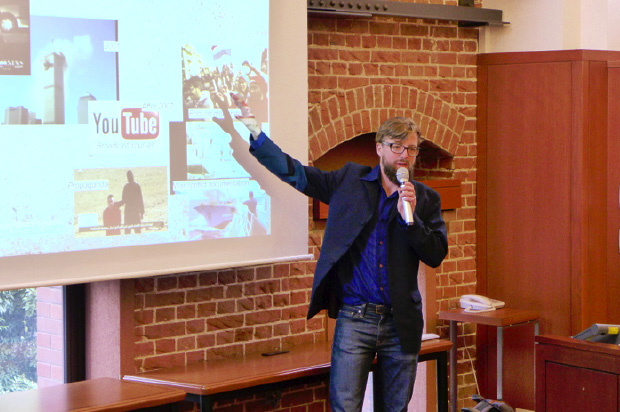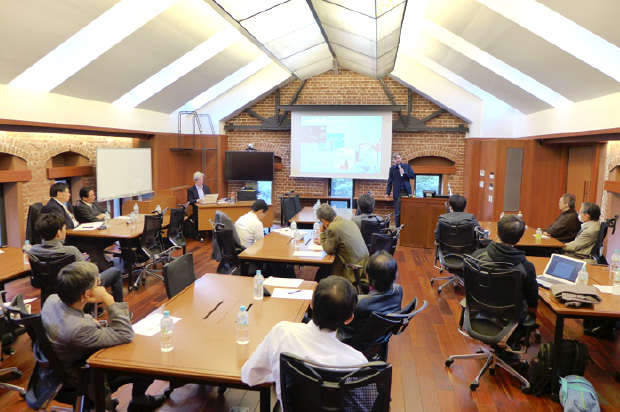SSU Forum with Dr. Rune Saugmann Andersen
| Date: | Thursday, November 12 2015, 10:30-12:00 |
|---|---|
| Venue: | Conference Room, 3rd Floor, Ito International Research Center |
| Subject: | Video, securitization and algorithms - towards understanding video as security articulation |
| Lecture: | Rune Saugmann Andersen, Post-Doctoral Researcher of School of Management in politics, University of Tampere |
| Language: | English |
| Hosted by: | Security Studies Unit, Policy Alternatives Research Institute, the University of Tokyo |
Dr. Rune Saugmann Andersen, currently Postdoctoral Researcher at the University of Tampere (Finland), was the guest speaker at the SSU Forum hosted on November 12, 2015.
Professor Kiichi Fujiwara, Director of the SSU, was glad to introduce Dr. Saugmann to the audience as a young and very promising researcher in International Relations, who has recently completed his Ph.D. in Copenhagen under the supervision of Professor Ole Wæver, an extremely prominent scholar and main theorist in the elaboration of what came to be known as the Copenhagen School, namely a particular approach to the concept of security in international politics.
Dr. Saugmann opened his talk by expressing his gratitude to Professor Fujiwara, and to all those who contributed in making possible his sojourn in Tokyo. He then proceeded with a brief illustration of the talk’s topic, namely how videos have changed the way in which the process of securitisation occurs.

In order to allow the audience to understand his particular research interest, Dr. Saugmann has provided a general introduction about the way in which the Copenhagen School has conceptualised the question of security, and particularly how “securitisation” occurs, namely of how any issue can become a “security issue” within a political community. This happens in essence via a speech act, whereby some authoritative figure (the securitisation agent) claims that a particular issue or situation constitutes a danger for the security of the political community, and needs to be addressed, even sometimes in ways which transcend the normal framework of laws and procedures descending from liberal constitutional principles. If such speech act is successful in convincing the relevant audience, the securitisation is successful.
Dr. Saugmann is currently studying a new element in this securitisation process, namely the role of videos, as opposed to the articulation of speeches and other verbal forms of communication, especially in relation to the way in which videos are now produced and spread via social media and other internet tools throughout the audience.
Videos play important roles in the domain of security, not only in the process of securitising an issue, but also in other domains, for instance in the integration of cameras within weapon systems.
He remarked how, even just in comparison to a handful of years ago, the production of videos is now attainable by anybody with a mobile phone or similar device equipped with a camera. Consequently, there is an enormous amount of events, with many more or less immediately related to security questions, which are filmed every day. Secondly, the nature of the process by which such videos are presented to the public has also considerably changed. In 1991, the video showing Rodney King being beaten by the Los Angeles police caused a public opinion uproar and rioting after it was delivered to “traditional” media, namely TV channels, and broadcast. There was therefore a filter between those who happen to produce a video and the process of diffusion to the public, made by the editorial boards of the traditional media.
Such media still play an important role in the dissemination of information and of videos, but other channels have in the meantime appeared. After the creation of YouTube in 2007 and other similar websites, anybody is able to upload and hence “publish” any video. Traditional editing can therefore be bypassed. Dr. Saugmann then also illustrated a shift in the creation of audiences. While in the past the audience was, and still is to a certain extent, created by the authoritativeness of the medium, in the realm of social media and the internet, in a sense, the audience shapes the audience itself. How is that possible? This occurs since the videos and other contents which are offered by the various websites to the users are selected automatically by the servers running specific algorithms. The more an item is viewed, the more it will be proposed to other viewers by the servers. The process is therefore entirely automatised.
Going back to the initial question of how securitisation is affected by the diffusion of videos, Dr. Saugmann added that videos, as opposed to the verbal articulation of an argument, are often perceived by the public as truthful representations of the reality, and may therefore represent a more sophisticated and penetrating way to push for the securitisation of a certain issue, even if videos can be manipulated or even staged. The importance of videos in the theory of securitisation is also increased by considering that, since the diffusion of a certain video may occur in automatised fashion by internet servers, it is unclear who the securitising agent actually is. Diffuse securitization makes it difficult to attribute responsibility as nobody and everybody seems to be responsible for invoking security. The process becomes in this sense more opaque, less explicit, and hence more resistant to rational analysis within the public sphere.

